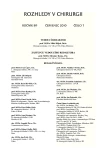Surgical Management of the Failed Back Surgery Syndrome (FBSS) Using Posterior Lumbar Interbody Fusion (PLIF) with Posterior Transpedicular Stabilization
Authors:
V. Kaťuch 1; F. Pataky 1; J. Kaťuchová 2; M. Gajdoš 1; J. Radoňak 2
Authors‘ workplace:
Neurochirurgická klinika LF UPJŠ a FNLP Košice, Slovenská republika
prednosta: doc. MUDr. M. Gajdoš, CSc., mim. prof.
1; I. chirurgická klinika LF UPJŠ a FNLP Košice, Slovenská republika, prednosta: prof. MUDr. J. Radoňak, CSc.
2
Published in:
Rozhl. Chir., 2010, roč. 89, č. 7, s. 450-458.
Category:
Monothematic special - Original
Overview
Introduction:
One of possibility of treatment FBSS is posterior lumbar interbody fusion, PLIF with posterior transpedicular stabilization.
Material and Methods:
Between January 2005 and December 2007, the prospective study of treatment failed back surgery syndrome patients with posterior lumbal interbody fusion and posterior transpedicular stabilization was performed at the Department of Neurosurgery University Hospital FNLP in Kosice. Physical examinations were performed before surgery, after surgery 30 days, and at 4 follow-up visits (3 months, 6 months, 12 months and 24 months). At each interval, patients outcomes measures, including visual analog scale pain rating VAS and Oswestry Disability Index ODI.
Results:
At the Department of Neurosurgery, 58 failed back surgery syndrome patients were operated on between 1. 1. 205 and 31. 12. 2007. Long term follow up was investigated in 47 patients, 11 patients were lost to follow-up.
Postoperative complications were controlled 30 days after surgery. They were presented in 9 patients (19.14%). No patient died after surgery.
The working ability was found in 23 patients 49%. Before surgery all patiens used analgesic, after surgery there were present decrese in using analgesic. Improvement quality of life and decrease pain measured with ODI and VAS were investigated. ODI before surgery was 71.7 and 24 months after surgery ODI was 37,7. VAS before surgery was 7.95 and 24 months after surgery VAS was 2.82. There were found statistically significant influence on decrease pain mesuares ODI and VAS after surgery p < 0.0001.
Conclusion:
Our study results show that PLIF with posterior transpedicular stabilization can be safely perfomed and that can allow decrease pain and improve quality of life in FBSS patients.
Key words:
failed back surgery syndrome – posterior lumbar interbody fusion with posterior trasnpedicular stabilization – quality of life
Sources
1. Deyo, R. A., Gray, D. T., Kreuter, W., Mirza S., Martin, B. I. Unites States trends in lumbar fusion surgery for degenerative conditions. Spine, 2005; 30: 1441–1445.
2. Schofferman, J., Reynolds, J., Herzog, R., Covington, E., Dreyfuss, P., O’Neill, C. Failed beck surgery: etiology and diagnostic evaluation. The Spine Journal, 2003; 3: 400–403.
3. Anderson, V. C. A rationale for treatment algorithm of failed back surgery syndrome. Current review of Pain, 2000; 4: 395–406.
4. Dario, A., et al. Treatment of failed back surgery syndrome. Neuromodulation, 2001; 4: 105–110.
5. Fairbank, J. C., Pynsent, P. B. The Oswestry Disability Index. Spine, 2000; 25: 2940–2952.
6. Arnold, P. M., Robbins, S., Paullus, W., Faust, S., Holt, R., McGuire, R. Clinical outcomes of lumbar degenerative disc disease treated with posterior lumbar interbody fusion allograft spacer : a prospective multicentic trial with 2 year follow-up. Am. J. Orth., 2009; 38: 115–122.
7. Cloward, R. B. The treatment of ruptured lumbar intervertebral disc by vertebral body fusion. Indicates, operative technique, after care. J. Neurosurg., 1953;10: 154–168.
8. Mirza, S. K., Deyo, R. A. Systematic review of randomized trials comparing lumbar fusion surgery to nonoperative care for treatment of chronic back pain. Spine, 2007; 32: 816–823.
9. Rudinský, B. (Ed.) Spinálna chirurgia, 1. vydanie, Svornosť, a.s., Bratislava 2006, 313 s., ISBN 80-89104-76-2.
10. North, R. B., Campbell, J. N., James, C. S., Conover-Walker, M. K., Wang, H., Piantadosi, S., Rybock, J. D., Long, D. M. Failed back surgery syndrome: 5-year follow-up in 102 patients undergoing repeated operation. Neurosurgery, 1991; 28: 685–691.
11. Skaf, G., Bouclaos, C., Alaraj, A.,Chamoun, R. Clinical outcomes of surgical treatment of failed back surgery syndrome. Surgical Neurology, 2005; 64: 483–489.
12. Glassman, S. D., Gornet, M. F., Branch, Ch., Polly, D., Peloza, J., Schwender, J. D., Carreon, L. MOS Short Form 36 and Oswestry Disability Index outcomes in lumbar fusion: a multicenter experience. The Spine Journal, 2006; 6: 21–26.
13. Agazzi, S., Reverdin, A., May, D. Posterior lumbar interbody fusion with cages: an independent review of 71 cases. J. Neurosurg., 1999; 91: 186–192.
14. Barnes, B., Rodts, G. E., McLaughlin, M. R., Haid, R. W. Threaded cortical bone dowels for lumbar interbody fusion:over 1 year mean follow-up in 28 patients. J. Neurosurg., 2001; 95: 1–4.
15. Lowe, T. G., Tahernia, A. D., O‘Brien, M. F., Smith, D. A. Unilateral transforaminal posterior lumbar interbody fusion TLIF, indications, technique, and 2-years results. J. Spine Disord. Tech. 2002; 15: 31–38.
Labels
Surgery Orthopaedics Trauma surgeryArticle was published in
Perspectives in Surgery

2010 Issue 7
- Metamizole vs. Tramadol in Postoperative Analgesia
- Metamizole at a Glance and in Practice – Effective Non-Opioid Analgesic for All Ages
- Current Insights into the Antispasmodic and Analgesic Effects of Metamizole on the Gastrointestinal Tract
Most read in this issue
- Small Intestine Invagination in an Adult
- Ovarial Hyperstimulation Syndrome in the Differential Diagnostics of Acute Abdomen
- Uncommon Rectal Adenocarcinoma Metastases
- Significance of the Sentinel Lymph Node Biopsy in Early Breast Carcinomas
